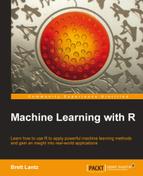- Machine Learning with R
- Table of Contents
- Machine Learning with R
- Credits
- About the Author
- About the Reviewers
- www.PacktPub.com
- Preface
- 1. Introducing Machine Learning
- 2. Managing and Understanding Data
- R data structures
- Vectors
- Factors
- Managing data with R
- Exploring and understanding data
- Exploring the structure of data
- Exploring numeric variables
- Measuring the central tendency – mean and median
- Measuring spread – quartiles and the five-number summary
- Visualizing numeric variables – boxplots
- Visualizing numeric variables – histograms
- Understanding numeric data – uniform and normal distributions
- Measuring spread – variance and standard deviation
- Exploring categorical variables
- Exploring relationships between variables
- Summary
- 3. Lazy Learning – Classification Using Nearest Neighbors
- 4. Probabilistic Learning – Classification Using Naive Bayes
- Understanding naive Bayes
- Example – filtering mobile phone spam with the naive Bayes algorithm
- Summary
- 5. Divide and Conquer – Classification Using Decision Trees and Rules
- Understanding decision trees
- Example – identifying risky bank loans using C5.0 decision trees
- Understanding classification rules
- Example – identifying poisonous mushrooms with rule learners
- Summary
- 6. Forecasting Numeric Data – Regression Methods
- Understanding regression
- Example – predicting medical expenses using linear regression
- Understanding regression trees and model trees
- Example – estimating the quality of wines with regression trees and model trees
- Summary
- 7. Black Box Methods – Neural Networks and Support Vector Machines
- 8. Finding Patterns – Market Basket Analysis Using Association Rules
- 9. Finding Groups of Data – Clustering with k-means
- Understanding clustering
- Clustering as a machine learning task
- The k-means algorithm for clustering
- Finding teen market segments using k-means clustering
- Step 1 – collecting data
- Step 2 – exploring and preparing the data
- Step 3 – training a model on the data
- Step 4 – evaluating model performance
- Step 5 – improving model performance
- Summary
- Understanding clustering
- 10. Evaluating Model Performance
- 11. Improving Model Performance
- 12. Specialized Machine Learning Topics
- Index
In this chapter, we learned about the basics of managing data in R. We started by taking an in-depth look at the structures used for storing various types of data. The foundational R data structure is the vector, which is extended and combined into more complex data types such as lists and data frames. The data frame is an R data structure that corresponds to the notion of a dataset, having both features and examples.
We also learned about how to get data into R from a variety of sources. R provides functions for reading from and saving to CSV files; SQL databases can be queried with the RODBC package.
Finally, we applied these skills while exploring a real-world dataset containing data on used car prices. We examined numeric variables using common summary statistics of center and spread, and visualized relationships between prices and odometer readings with a scatterplot. We examined nominal variables using tables. In examining the used car data, we followed an exploratory process that can be used to understand any dataset.
Now that we have spent some time understanding the basics of data management with R, you are ready to begin using machine learning to solve real-world problems. In the next chapter, we will tackle our first classification task using nearest neighbor methods.
-
No Comment
